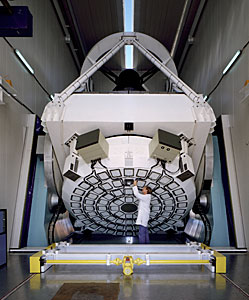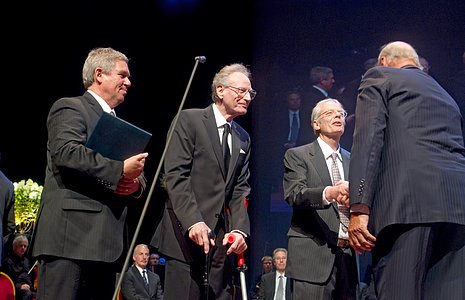Actieve optiek
Een baanbrekende uitvinding
De grootte doet er echt toe, en de vorm ook. Beide zijn van belang als het om de bouw van krachtigere telescopen gaat. Grote hoofdspiegels stellen astronomen in staat om meer licht op te vangen en een volmaakt gevormd spiegeloppervlak is nodig om beeldvertekening te voorkomen. De effectieve combinatie van de twee maakt het mogelijk om zwakke objecten waar te nemen. Helaas is dat nog niet zo eenvoudig, omdat telescoopspiegels zich moeilijker in vorm laten houden naarmate ze groter zijn
Het belang van deze uitdaging ontstond in de jaren zestig en zeventig. Met de destijds beschikbare technologie konden astronomen en ingenieurs geen telescopen bouwen met een hoofdspiegel met een middellijn van van meer dan vijf meter. Bij grotere afmetingen nam de beeldkwaliteit enorm af, doordat de zwaartekracht de spiegels uit vorm trok. Om zulke spiegels in vorm te houden, had men in die tijd enorme ondersteunende constructies nodig en dat dreef de kosten sterk op. Er moest een nieuwe manier worden gevonden om de optische nauwkeurigheid te garanderen.
Toen kwam ESO-ingenieur Raymond Wilson met het briljante en ‘simpele’ idee van de actieve optiek. Een dunne en vervormbare hoofdspiegel zou in bedwang worden gehouden door een actief ondersteuningssysteem dat precies de juiste kracht zou toepassen om de door de zwaartekracht veroorzaakte vervormingen te corrigeren die optraden wanneer de telescoop van stand veranderde. (Meer hierover valt te lezen in het gratis boek Jewel on the Mountaintop van Claus Madsen.)
Toen in 1976 ESO’s 3.6-metre telescope in gebruik werd genomen, bestond actieve optiek alleen nog in het hoofd van Wilson. Vandaar dat de hoofdspiegel van de telescoop een halve meter dik is en maar liefst 11 ton weegt.
Het nieuwe concept werd op het ESO-hoofdkwartier getest met een dunne spiegel van 1 meter en een actief ondersteuningssysteem van 75 actuatoren. Actuatoren zijn motortjes die heel nauwkeurig bewegen en kunnen worden aangestuurd. Door tegen de spiegel aan te drukken, corrigeren zij diens vorm en kunnen ze diens vervorming ten gevolge van de zwaartekracht tenietdoen. Wanneer de telescoop beweegt, kan dit actieve systeem de spiegel in de juiste vorm houden. De correcties die de actuatoren moeten toepassen worden in realtime berekend door een computer met een beeldanalisator die zelfs de kleinste afwijkingen van de ideale spiegelvorm kan detecteren. Actieve optiek werd binnen ESO ontwikkeld en na de geslaagde proeven toegepast in de New Technology Telescope (NTT). Dankzij actieve optiek heeft is de 3,58 meter grote hoofdspiegel van de NTT maar 24 centimeter dik en 6 ton zwaar.
Sinds de NTT in 1990 in bedrijf kwam, heeft actieve optiek een enorme vlucht genomen. Het systeem wordt in alle grote telescopen toegepast, inclusief ESO’s Very Large Telescope (VLT). Voor zijn baanbrekende uitvinding heeft Wilson tal van onderscheidingen ontvangen.
De vier Unit Telescopes van de VLT zijn stuk voor stuk uitgerust met het beste systeem voor actieve optiek. Met het systeem worden zowel de 8,2-meter Zerodur-hoofdspiegel als de lichte 1,1-meter beryllium hulpspiegel bovenin de telescoopstructuur bestuurd. Naar gelang de signalen die het systeem geeft worden de telescoopspiegels met regelmatige tussenpozen automatisch bijgesteld.
Dankzij deze technologie hoeven de hoofdspiegels van de vier Unit Telescopes, die elk een middellijn van 8,2 meter hebben en 22 ton wegen, maar 17 centimeter dik te zijn – de vorm van een reusachtige pannenkoek! Elke spiegel rust op 150 computergestuurde steunpunten die zijn verankerd in een extreem vormvaste cel die ongeveer 11 ton weegt. Het actieve optische systeem van de VLT garandeert dat deze grote spiegels altijd de optimale vorm hebben en altijd eersteklas foto’s van het heelal afleveren
Inmiddels staat de techniek van de actieve optiek voor een nieuwe grote uitdaging: de 39-meter grote hoofdspiegel van de in aanbouw zijnde Extremely Large Telescope (ELT). Deze spiegel zal bestaan uit 798 afzonderlijke segmenten die met behulp een zuigermechanisme gekanteld kunnen worden, om de effecten van temperatuurfluctuaties en de zwaartekracht te compenseren.
Deze ESOcast vertelt meer over actieve optiek en verwante technieken: Seeing Sharp — Special 50th anniversary episode #3.
Wetenschappelijke hoogtepunten
De actieve optische systemen die in de diverse ESO-telescopen zijn geïnstalleerd hebben opmerkelijke ontdekkingen mogelijk gemaakt:



